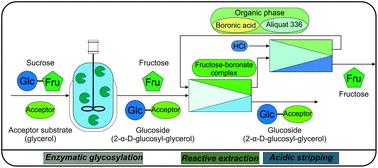当前位置:
X-MOL 学术
›
Green Chem.
›
论文详情
Our official English website, www.x-mol.net, welcomes your
feedback! (Note: you will need to create a separate account there.)
Reactive extraction of fructose for efficient separation of sucrose-derived glucosides produced by enzymatic glycosylation
Green Chemistry ( IF 9.3 ) Pub Date : 2020-06-30 , DOI: 10.1039/d0gc01408g Andreas Kruschitz 1, 2, 3 , Bernd Nidetzky 1, 2, 3, 4, 5
Green Chemistry ( IF 9.3 ) Pub Date : 2020-06-30 , DOI: 10.1039/d0gc01408g Andreas Kruschitz 1, 2, 3 , Bernd Nidetzky 1, 2, 3, 4, 5
Affiliation

|
The disaccharide sucrose (α-D-glucopyranosyl-1,2-β-D-fructofuranoside) is a highly efficient donor substrate for enzymatic glucosylation reactions. A large number of commercially relevant glucosides are produced via this general route. Every sucrose-based glucosylation involves co-production of D-fructose in amounts corresponding to the target glucoside. A separation technology for selective removal, and efficient recovery, of the D-fructose co-product would be highly desirable as a generic platform for downstream process development. Here, we demonstrate organoboronate-complex reactive extraction of D-fructose into an 1-octanol/hexane (4/1, v/v) solvent using methyltrioctyl ammonium chloride as phase transfer catalyst and extractant. We show separation of the D-fructose co-product (100 mM) from equimolar mixture with 2-α-D-glucosyl-glycerol, a cosmetic ingredient that is manufactured industrially from sucrose and glycerol using sucrose phosphorylase. With the main parameters of extraction, stripping and organic phase recycling identified and their effect on product/co-product yield and purity characterized, we developed a three-step extraction process with alternating extraction and stripping stages that removed the D-fructose efficiently at 50 ml operating scale. 2-α-D-glucosyl-glycerol and D-fructose were cleanly separated and obtained in excellent purity (≥90%) at a recovery of 90% and 83%, respectively. Reactive extraction appears to be faster and more selective and resource-efficient than applicable alternatives for separation, including chromatography and membrane nanofiltration. Thus, the established extraction process is promising for industrial application. It could be generically useful to separate D-fructose from glucosides.
中文翻译:

反应性提取果糖可有效分离酶促糖基化作用产生的蔗糖衍生糖苷
二糖蔗糖(α - D-吡喃葡萄糖基-1,2-β- D-果糖呋喃糖苷)是用于酶促糖基化反应的高效供体底物。通过该一般途径可生产大量与商业相关的葡糖苷。每种基于蔗糖的葡萄糖基化都涉及与目标糖苷相对应的D-果糖的联合生产。作为用于下游工艺开发的通用平台,非常需要用于选择性除去和有效回收D-果糖副产物的分离技术。在这里,我们展示了D的有机硼酸酯-络合物反应萃取使用甲基三辛基氯化铵作为相转移催化剂和萃取剂,将果糖转化为1-辛醇/己烷(4/1,v / v)溶剂。我们示出了分离d从等摩尔混合物与2-α--fructose共产物(100毫摩尔)d -glucosyl甘油中,从蔗糖工业制造和使用蔗糖磷酸甘油的化妆品成分。确定了萃取,汽提和有机相再循环的主要参数,并表征了它们对产物/副产物收率和纯度的影响,我们开发了一种三步萃取工艺,具有交替的萃取和汽提阶段,可在50℃下有效去除D-果糖。毫升操作规模。2-α- D-葡萄糖基甘油和D干净地分离出果糖,并以优异的纯度(≥90%)得到回收率分别为90%和83%的果糖。反应性萃取似乎比适用于色谱分离和膜纳米过滤的替代方法更快,更具选择性和资源效率。因此,已建立的提取方法有望用于工业应用。从糖苷中分离D-果糖可能通常是有用的。
更新日期:2020-08-04
中文翻译:

反应性提取果糖可有效分离酶促糖基化作用产生的蔗糖衍生糖苷
二糖蔗糖(α - D-吡喃葡萄糖基-1,2-β- D-果糖呋喃糖苷)是用于酶促糖基化反应的高效供体底物。通过该一般途径可生产大量与商业相关的葡糖苷。每种基于蔗糖的葡萄糖基化都涉及与目标糖苷相对应的D-果糖的联合生产。作为用于下游工艺开发的通用平台,非常需要用于选择性除去和有效回收D-果糖副产物的分离技术。在这里,我们展示了D的有机硼酸酯-络合物反应萃取使用甲基三辛基氯化铵作为相转移催化剂和萃取剂,将果糖转化为1-辛醇/己烷(4/1,v / v)溶剂。我们示出了分离d从等摩尔混合物与2-α--fructose共产物(100毫摩尔)d -glucosyl甘油中,从蔗糖工业制造和使用蔗糖磷酸甘油的化妆品成分。确定了萃取,汽提和有机相再循环的主要参数,并表征了它们对产物/副产物收率和纯度的影响,我们开发了一种三步萃取工艺,具有交替的萃取和汽提阶段,可在50℃下有效去除D-果糖。毫升操作规模。2-α- D-葡萄糖基甘油和D干净地分离出果糖,并以优异的纯度(≥90%)得到回收率分别为90%和83%的果糖。反应性萃取似乎比适用于色谱分离和膜纳米过滤的替代方法更快,更具选择性和资源效率。因此,已建立的提取方法有望用于工业应用。从糖苷中分离D-果糖可能通常是有用的。











































 京公网安备 11010802027423号
京公网安备 11010802027423号